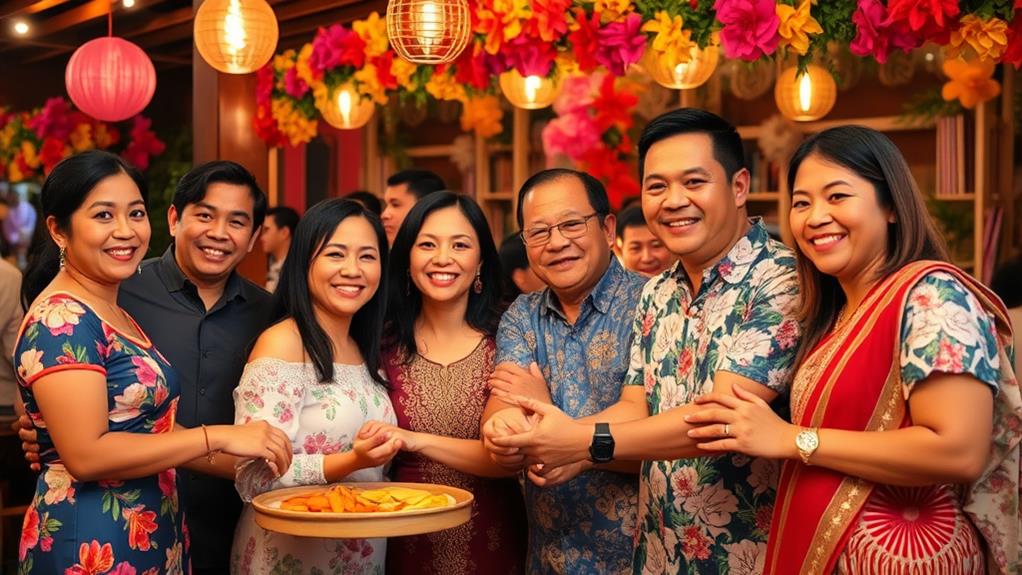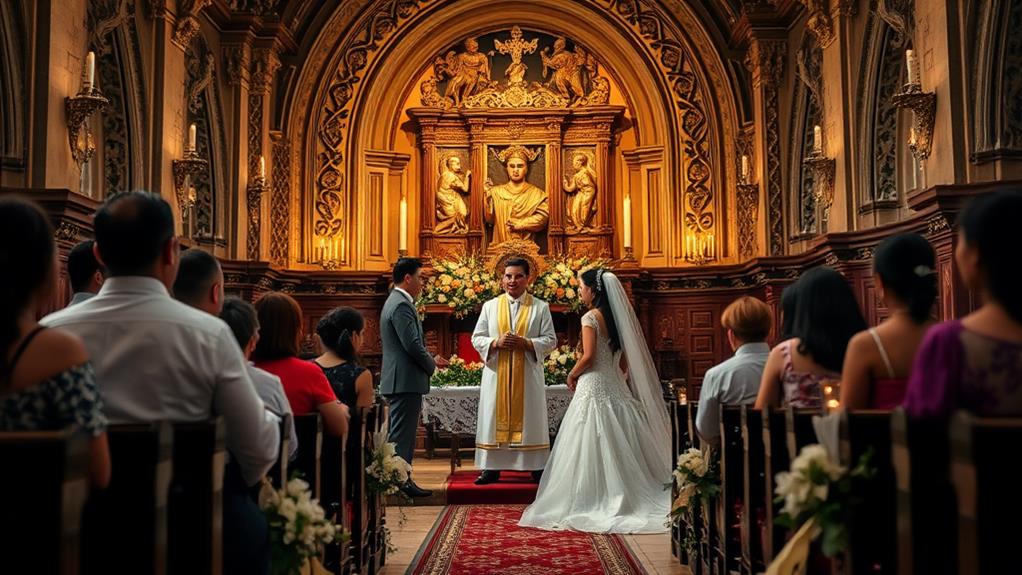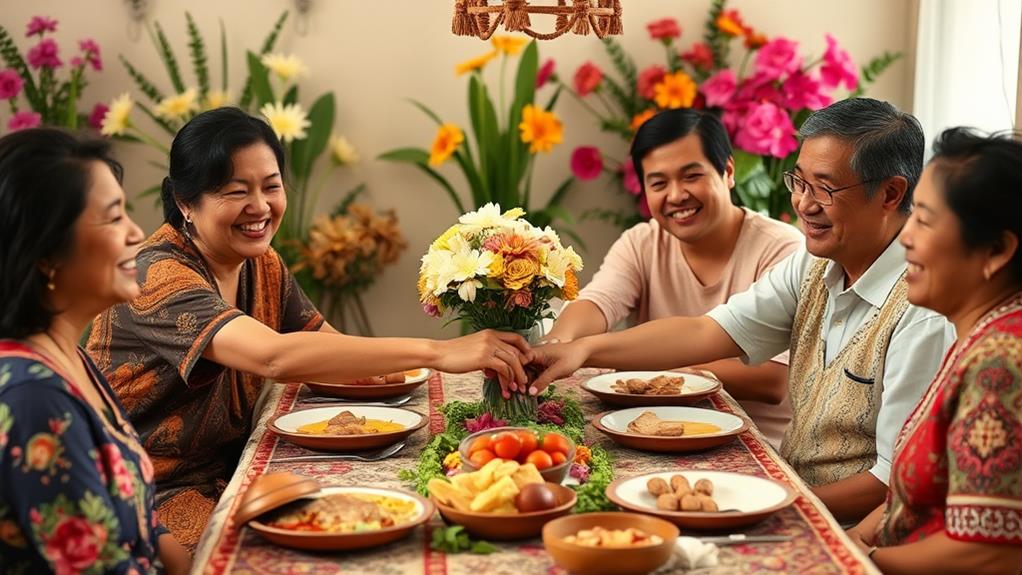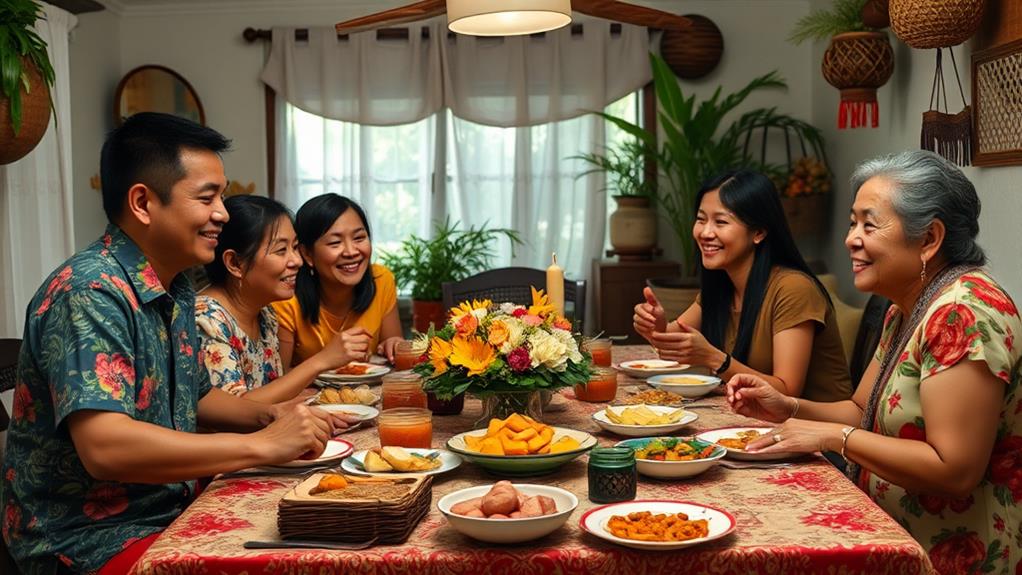Traditional Filipino ceremonies are an integral part of Filipino identity.
These ceremonies, which mark significant life events, serve as a foundation for unity, love, and community bonding. Examples of such events include birthdays, weddings, and town fiestas.
In the Philippines, communities often come together to honor these milestones and special occasions.
Filipino communities celebrate traditional ceremonies 20-30 times annually.
These celebrations provide an opportunity to foster deeper connections to heritage and cultural practices.
By embracing these ceremonies, individuals can discover the beauty of Filipino cultural practices that make life's moments truly special.
Importance of Filipino Celebrations

Filipino celebrations play a significant role in fostering a sense of identity and belonging within families. These celebrations honor every achievement and milestone, no matter how small. They create lasting memories and strengthen familial and social connections, emphasizing the importance of togetherness.
Regular family gatherings during celebrations are a staple in Filipino culture, reinforcing family bonds and cultural heritage. For example, birthdays, graduations, and holidays are often celebrated with family gatherings. These events motivate individuals to strive for further success and enhance overall well-being.
Food sharing is a cultural norm during celebrations, representing hospitality and community ties among friends and neighbors. In Filipino culture, food is often served during gatherings, such as lechon (roasted pig) during fiestas and special occasions.
Filipino families don't limit celebratory events to grand occasions like weddings. Instead, they're an integral part of their family traditions, providing joy during uncertain times and serving as a reminder of the positivity and connection that's prioritized in their cultural heritage.
Engagement and Wedding Traditions
Filipino Engagement Traditions Emphasize Family and Unity
Filipino engagement traditions primarily focus on strengthening family ties and unity. One key tradition is the Pamamanhikan, where the groom's family visits the bride's home to formally ask for her hand in marriage. This custom establishes respect between the two families and sets the foundation for a strong relationship.
Family Plays a Vital Role in Filipino Weddings
Family members are essential participants in Filipino weddings. Before the ceremony, couples seek parental blessings from both families to reinforce family bonds and show gratitude. These blessings are crucial in Filipino culture, as they signify the union of two families.
Sponsors and Symbolic Ceremonies Enhance the Celebration
Sponsors, often family members, play a significant role in the wedding ceremony. Their presence enhances the couple's support system and represents community involvement in their marriage journey.
Additionally, symbolic veil ceremonies, such as the "Veil Sponsors" who cover the bride and groom with a veil, underscore the cultural significance of marriage in Filipino traditions.
Celebrating Unity and Harmony
Traditional Filipino Wedding Ceremonies

Traditional Filipino wedding ceremonies are a celebration of the couple's love and commitment, rich in cultural heritage and symbolism. These ceremonies often combine pre-colonial practices with contemporary customs.
The wedding process begins with the pamamanhikan, where the groom's family visits the bride's home to signify respect and the start of their marriage journey. This tradition is a key part of the wedding preparations and serves as a formal introduction between the two families.
During the ceremony, three key rituals take place: the veil, cord, and coin ceremonies. The veil ceremony symbolizes the union of the couple, while the cord ceremony represents the couple's bond and commitment to one another. The coin ceremony represents the couple's future prosperity.
Traditional attire is also an important part of the ceremony, with the bride wearing a Filipiniana gown featuring butterfly sleeves and the groom wearing an embroidered barong. This attire reflects the cultural significance and adherence to Filipino wedding traditions.
The presence of sponsors, or ninongs and ninangs, plays a significant role in the ceremony, as they provide support and guidance to the couple.
These sponsors are typically close family friends or relatives who've been chosen for their wisdom and experience.
Celebrating Life Milestones and Successes
Celebrating Life Milestones and Successes in Filipino Culture
Filipinos place great importance on celebrating life milestones and successes, no matter how small. Every achievement is a reason to celebrate. In Filipino culture, gatherings are common to mark significant life events such as birthdays, graduations, and job promotions. These celebrations also acknowledge minor triumphs within the family, which fosters a culture of positivity and encouragement.
Traditional Filipino Celebrations
Traditional Filipino celebrations typically feature culinary delights, with food serving as a reward and a symbol of hospitality. Friends and family gather around the table, sharing stories and laughter while enjoying traditional dishes.
For instance, during birthdays, Filipinos often serve lechon (roasted pig) or adobo (a popular Filipino stew). Food plays a central role in Filipino celebrations, strengthening bonds of love and creating lasting memories through shared experiences.
The Importance of Celebrating Successes
Regularly celebrating successes motivates individuals to strive for further achievements and reinforces the importance of community and connection in Filipino culture.
Celebrating life milestones is essential to the traditional Filipino way of life. By acknowledging and honoring achievements, Filipinos nurture their relationships with loved ones and emphasize the value of community and support.
Strengthening Family Bonds Through Traditions

Strengthening family bonds through traditions is a cornerstone of Filipino culture. Filipino families use traditions as a foundation for fostering unity and love among relatives.
Traditional ceremonies play a significant role in strengthening family bonds. In Filipino culture, these ceremonies serve as a foundation for fostering unity and love among relatives. A wedding, for example, is a celebration that brings loved ones together, marking the beginning of a new family.
Filipino traditions foster a sense of identity and belonging. Regular celebrations of traditional ceremonies, such as family reunions and fiestas, create a sense of identity and belonging among family members. For instance, a family reunion during the holiday season brings together relatives who live far apart, allowing them to reconnect and strengthen their bond.
Celebrations create lasting memories. Simple gatherings, like family dinners or small celebrations for achievements, strengthen connections by creating lasting memories and encouraging open communication among relatives. For example, a family dinner to celebrate a child's graduation creates a lasting memory and allows relatives to share in the child's accomplishment.
Filipino culinary traditions emphasize hospitality and community spirit. Sharing Filipino dishes during celebrations serves as a vital element, emphasizing the importance of hospitality and community spirit in Filipino culture. Traditional dishes like adobo and lechon are often served during celebrations, bringing family members together to enjoy a meal.
Traditional activities pass down customs and values. Engaging in traditional activities and games during celebrations helps pass down customs and values, ensuring that younger generations remain connected to their family's heritage and traditions.
For example, playing traditional Filipino games like "Piko" or "Lumpia" during a family reunion teaches younger generations about their cultural heritage.
Filipino Cultural and Spiritual Practices
Filipino cultural and spiritual practices are deeply intertwined. This connection is evident in various aspects of life, especially during significant events and celebrations.
Traditionally, Filipino families celebrate ceremonies that center around life events, such as baptisms, weddings, and funerals. These events typically occur once per significant life event, but the frequency of celebrations can vary depending on cultural importance and familial traditions. For example, a baptism is a one-time event that usually occurs shortly after birth, while a wedding is a singular celebration of a couple's union.
In addition to life events, many Filipino families observe annual rituals. Honoring the deceased on All Souls' Day is a significant cultural practice. This day is dedicated to remembering and celebrating the lives of loved ones who've passed away, highlighting the importance of family and respect for ancestors.
Community festivities, such as town fiestas or religious celebrations, are also common in Filipino culture. These events often occur multiple times throughout the year, fostering communal bonds and cultural identity. Town fiestas, for instance, bring together community members to celebrate local traditions and heritage.
The blending of cultural and spiritual practices is evident in traditional Filipino ceremonies. A wedding reception may follow a church ceremony, demonstrating the significance of both cultural heritage and spiritual beliefs on a special day. This integration of practices highlights the importance of faith and tradition in Filipino culture.
How Does the Rise of Evangelical Christianity Impact Traditional Filipino Ceremonies?
The growth of evangelical christianity significantly impacts traditional Filipino ceremonies. As more people convert to this denomination, there may be a decrease in the participation and influence of traditional rituals and customs in Filipino communities. The shift in religious beliefs can alter the cultural landscape and practices.
Personalizing Celebrations With Family Traditions

Incorporating family traditions into celebrations is an effective way to add a personal touch to cultural events. By doing so, you honor your heritage and create a sense of continuity between generations. To make the experience even more meaningful, consider incorporating the following elements into your celebrations.
1. Family recipes play a crucial role in making celebrations special. Incorporating unique culinary recipes passed down through generations allows you to share a piece of your family's history with guests. For example, in Filipino culture, dishes like adobo and lechon are often served during special occasions.
By serving these dishes, you can connect with your heritage and create a sense of nostalgia among family members.
2. Storytelling and games are essential in fostering a deeper sense of identity among family members. Engage in activities that reflect your shared history, such as sharing stories about your ancestors or playing traditional games like "Tinikling" or "Lupang Hinirang".
These activities help create a sense of belonging among family members.
3. Traditional songs and dances are an integral part of Filipino cultural events. Including custom elements like traditional songs and dances allows you to honor your heritage while creating new memories.
For example, you can hire a live band to play traditional Filipino music or teach family members a traditional dance like the "Pandanggo sa Ilaw".
4. Personalized vows or speeches are a great way to make the occasion more meaningful and personal. Highlight the couple's or individual's journey and values, and explain how these values have been shaped by your family's history and traditions.
Preserving Filipino Heritage Through Festivals
Preserving Filipino Heritage Through Festivals
Festivals play a crucial role in preserving a nation's cultural heritage. In the Philippines, these celebrations are an integral part of a Filipino's sense of identity and connection to their heritage.
Filipino culture's strong Roman Catholic faith influence is evident in its festivals, many of which are centered around patron saints. The celebration of patron saints is a way for Filipinos to express their devotion and gratitude to their faith.
Some notable festivals in the Philippines include:
| Festival | Description |
|---|---|
| Sinulog | A festival in honor of the Santo Niño, featuring street dancing and vibrant costumes |
| Masskara Festival | A celebration of resilience and community spirit, known for its colorful masks and street dancing |
| Ati-Atihan | A festival commemorating the arrival of Malay datus in the island of Panay, featuring street dancing and warrior costumes
These festivals not only showcase Filipino culture but also provide a sense of community and belonging among its people.
Questions and Answers
What Is the Sequence of a Filipino Wedding Ceremony?
A Filipino wedding ceremony sequence is a series of traditional events that make up the celebration. The sequence begins with pamamanhikan, which is a meeting between the groom's family and the bride's family to formally ask for her hand in marriage.
The ceremony then proceeds to a Catholic Mass, which includes three significant rituals: the candle ceremony, the veil ceremony, and the cord ceremony. The candle ceremony symbolizes the union of two families through the lighting of candles. The veil ceremony represents the unity and protection of the couple, where a veil is placed over the bride's head and the groom's shoulder. The cord ceremony signifies the eternal bond between the couple, where a cord is wrapped around their joined hands.
The ceremony concludes with a salu-salo reception, a traditional Filipino celebration featuring food, music, and dance. Guests typically wear traditional attire, such as the barong tagalog for men and the terno for women. The reception also features traditional Filipino music and dances, such as the tinikling and the pandanggo sa ilaw.
How Long Is a Traditional Filipino Wedding?
A traditional Filipino wedding typically lasts for three days and includes various customs and cultural attire. This extended celebration incorporates pre-wedding rituals, ultimately leading to a grand reception that showcases the family's heritage and cultural significance.
What Is the Engagement Tradition in the Philippines?
The Pamamanhikan is a significant engagement tradition in the Philippines. This custom involves the groom's family visiting the bride's home to seek her parents' blessings and discuss wedding plans. This visit highlights the cultural significance of family involvement in pre-wedding rituals. By coming together, both families can build a stronger bond and create a smoother transition into the marriage.
Who Pays for a Filipino Wedding?
In a traditional Filipino wedding, the groom's family typically covers the major expenses. This includes costs such as venue rental, food, and entertainment. The bride's family, on the other hand, usually handles the expenses related to attire and accessories, including the wedding dress, veil, and jewelry. This division of expenses reflects the cultural expectations and family contributions in a Filipino wedding.